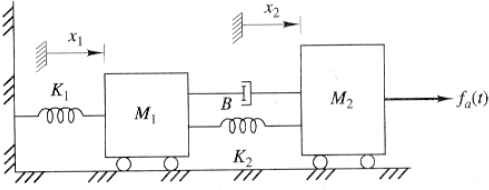ME 635: Modeling and Simulation Homework #7
Hello, dear friend, you can consult us at any time if you have any questions, add WeChat: daixieit
Homework #7
ME 635: Modeling and Simulation
Problem 1: Find the dynamic response of the system given below

The system is defined by the two ODEs given below:

1. Show the position (x1, x2)and velocity response for both the masses if M1 = 1; M2 = 2;
K1 = K2 = 10; B = 0.1. if Fa(t) = 10 t<=1 sec and Fa(t) = 0 t > 1 sec. Simulate the response for 20 seconds.
Show the Simulink model and plots for the responses requested.
2. Show the position and velocity response if the input, Fa(t) , is a pulse with an amplitude of 10, period of 1 second and a pulse width of 25%. Simulate for 20 seconds.
Problem 2: An accelerometer is described by the following state equations:

Where L is the inductance, Rc is the coil resistance, Rr is the recorder resistance, B is the magnetic flux resistance, M is the mass, C is the friction, K is the restoring spring constant, l is the coil length and ac is the base acceleration. If M = 1 Kg; K = 200 N/m and C = 0.2 N*s/m; B = 1 Weber/m2; l = 1 m; L = 10 mH; Rc = 0.1 ohms; Rr = 1 ohm.
Find the response e0 when the acceleration applied is: ac = 0.2 * sin(2pt)*e-0.1t; where t is the time. Simulate for 100 sec.
Show the input signal ac and the output e0 for both the cases. If having integration problems, change the time-stepping algorithm in MATLAB to find an algorithm that produces a convergence.
Problem 3: An acute-care facility treats non-emergency patients (cuts, colds, etc.). Patients arrive according to an exponential interarrival time distribution with a mean of 11 (all times are in minutes). Upon arrival they check in at a registration desk staffed by a single nurse. Registration times follow a triangular distribution with parameters 6, 10, and 19. After completing registration, they wait for an available examination room; there are three identical rooms. Data show that the patients can be divided into two groups with regard to different examination times. The first group (55% of patients) has service times that follow a triangular distribution with parameters 14, 22, and 39. The second group (45%) has triangular service times with parameters 24, 36, and 59. Upon completion, patients are sent home. The facility is open 16 hours each day. Make 200 replications of one day each and observe the average total time patients spend in the system.
Problem 4: A production system consists of four serial automatic workstations. The first part arrives at time zero, and then (exactly) every 9.8 minutes thereafter. All transfer times are assumed to be zero and all processing times are constant. There are two types of failures: major and jams. The data for this system are given in the table below (all times are in minutes). Use exponential distributions for the uptimes and uniform distributions for repair times (for instance, repairing jams at Workstation 3 is UNIF(2.8, 4.2)). Run your simulation for 10,000 minutes to determine the cycle time for the parts and instantaneous utilization for each resources.

Problem 5: A valve is assembled in two process cells by one worker in each cell, The first worker inserts spring and stem into the body with a TRIA(1,2,3) seconds process time; The second Worker closes the valve and test for leaks in TRIA (5,10,15) seconds. The valve parts arrive into the system at the rate of EXPO(15) seconds. Assume that about 3% of the assembled valve stems fail and must be disassembled by a machine within TRIA(1,2,3) seconds. The disassembled valves are reworked in stage 1 with the same process time as before. The valves must be reworked only once and any that fail after the one rework must be discarded.
2a. Show the model and all the relevant statistics about the process wait times and resource availabilities. Run the simulation for one shift of 8 hours. Estimate all averages with the half width of the 95 % CI within about 10 % of the mean.
2b. Determine approximately how many shifts of 8 hours will be required to assemble 100,000 parts.
2024-04-11